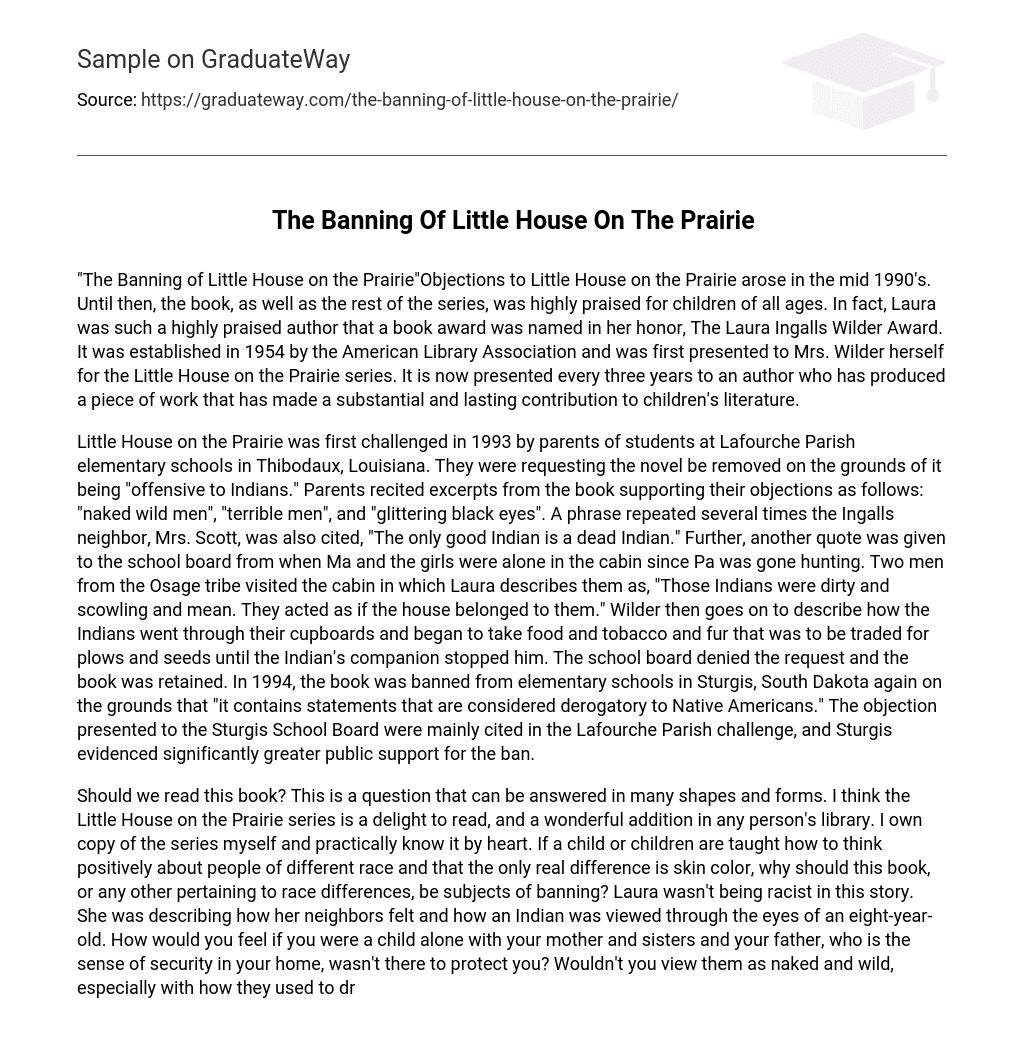In the mid 1990’s, objections to Little House on the Prairie arose despite its previous acclaim among children of all ages. Laura Ingalls Wilder, the esteemed author of the series, had even received a prestigious book award named after her – The Laura Ingalls Wilder Award. This award was established by the American Library Association in 1954 and originally bestowed upon Mrs. Wilder for her beloved Little House on the Prairie series. Currently, this accolade is granted every three years to an author who has made a lasting impact on children’s literature.
In 1993, parents of students at Lafourche Parish elementary schools in Thibodaux, Louisiana objected to the novel Little House on the Prairie due to its “offensive” content towards Native Americans. They specifically pointed out excerpts from the book that included descriptions like “naked wild men,” “terrible men,” and “glittering black eyes.” The phrase repeated by Mrs. Scott, a neighbor of the Ingalls family, stating that “The only good Indian is a dead Indian,” was also mentioned as problematic. Laura’s account of two Osage tribe men being described as dirty, scowling, and mean who acted possessively over their house further fueled these concerns. Laura recounted how they went through their cupboards and took food, tobacco, and fur meant for trading until another Indian intervened. Despite these objections, the school board refused to remove the book from circulation.
However, in 1994, Little House on the Prairie faced a ban in elementary schools in Sturgis, South Dakota for similar reasons regarding derogatory statements about Native Americans. The objections presented to the Sturgis School Board mirrored those made during the Lafourche Parish challenge; however, there was significantly more public support for banning it in Sturgis.
The question of whether or not to read this book can be answered in various ways. Personally, I find the Little House on the Prairie series to be a delightful and valuable addition to any library. I own a copy myself and am very familiar with it. If children are taught to have positive thoughts about people of different races and understand that skin color is the only true difference, there is no reason to ban this book or any other that discusses racial differences. In the story, Laura, the main character, was not being racist; she was simply describing how her neighbors felt and how an Indian was perceived through the innocent eyes of an eight-year-old child. Put yourself in the shoes of a fatherless child who relies on their home for security – wouldn’t you see unfamiliar people as being naked and wild, particularly considering their attire during Laura’s time? Interestingly enough, when both instances occurred where the novel was suggested for banning, it wasn’t mentioned that the children’s parents were Native American. However, it was deemed offensive towards Native Americans. In my opinion, those who took offense were actually using Native Americans as a convenient excuse.
BibliographyCraig, Alec. Suppressed Books. Cleveland, OH. The World Publishing Company. 1963.
De Grazia, Edward. Censorship landmarks. New York, N.Y. R.R. Bowker Company. 1969.
According to Foerstel, Herbert N., Free Expression and Censorship in America is a book published by Greenwood Press in 1997, based in Westport, CT.
Gabler, Norma. Ready Reference, Censorship. Pasadena, CA. Salem Press Inc. 1997.
Haight, Anne L. Banned Books. New York, N.Y. R.R. Bowker Co. 1978.
The book “Bookbanning in America” was written by William Noble and published in 1990 by Paul S. Eriksson in Middlebury, BT.
The book titled “Literature Suppressed on Social Grounds” was written by Dawn B. Sova and published by Facts OnFile, Inc. in 1998.
The book “Little House on the Prairie” was written by Laura Ingalls Wilder and published in 1971 by HarperCollins Publishers, Inc. It is set in New York, N.Y.





